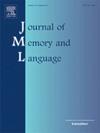Variation in the intensity and consistency of attention during learning: The role of conative factors
IF 3
1区 心理学
Q1 LINGUISTICS
引用次数: 0
Abstract
The present study examined whether conative factors (e.g., self-efficacy, self-set goal difficulty, and task-specific motivation) are reliable predictors of learning and memory abilities and whether any observed relationships could be explained by two related, yet distinct aspects of attention. Specifically, the present study examined whether the relationship between conative factors and overall learning performance is explained by attentional intensity (the amount of attention allocated to a task) and attentional consistency (the consistency with which attention is allocated to said task). In two studies (Ns > 160), participants completed a paired associate’s (PA) cued recall task while pupil diameter was simultaneously recorded to provide an index of the intensity of attention. Measures of working memory, general episodic long-term memory, task-specific motivation, and memory self-efficacy were also included. Study 2 adopted a similar procedure but embedded thought probes into the encoding phase of each list to provide an index of the consistency of attention. Study 2 also added measures of self-set goal difficulty and effective strategy use. Results suggested that all conative factors were related to intensity and consistency in challenging learning contexts. Furthermore, intensity, consistency, and the variance shared between self-efficacy and self-set goal difficulty (r = .86) each explained substantial unique variance in learning when controlling for the influence of other important predictors. Overall, results suggest conative factors are important for understanding individual differences in learning and memory abilities, and part of the reason why these factors are associated with improved learning outcomes is due to intensity and consistency.
学习过程中注意力强度和一致性的变化:条件因素的作用
本研究考察了内在因素(如自我效能、自我设定目标难度和任务特定动机)是否是学习和记忆能力的可靠预测因素,以及观察到的任何关系是否可以用两个相关但不同的注意方面来解释。具体而言,本研究考察了有意识因素与整体学习表现之间的关系是否可以用注意强度(分配到任务上的注意力数量)和注意一致性(分配到该任务上的注意力的一致性)来解释。在两项研究(Ns >;160),参与者完成了配对同伴(PA)提示的回忆任务,同时记录瞳孔直径,以提供注意力强度的指数。工作记忆、一般情景长期记忆、任务特定动机和记忆自我效能的测量也包括在内。研究2采用了类似的程序,但在每个列表的编码阶段嵌入了思想探索,以提供注意一致性的指标。研究2还增加了自我设定目标难度和有效策略使用的测量。结果表明,在具有挑战性的学习环境中,所有影响因素都与强度和一致性有关。此外,在控制了其他重要预测因素的影响后,强度、一致性和自我效能感与自我设定目标难度之间共享的方差(r = 0.86)各自解释了学习中实质性的独特方差。总的来说,研究结果表明,条件因素对于理解学习和记忆能力的个体差异很重要,这些因素与学习效果的改善有关的部分原因是由于强度和一致性。
本文章由计算机程序翻译,如有差异,请以英文原文为准。
求助全文
约1分钟内获得全文
求助全文
来源期刊
CiteScore
8.70
自引率
14.00%
发文量
49
审稿时长
12.7 weeks
期刊介绍:
Articles in the Journal of Memory and Language contribute to the formulation of scientific issues and theories in the areas of memory, language comprehension and production, and cognitive processes. Special emphasis is given to research articles that provide new theoretical insights based on a carefully laid empirical foundation. The journal generally favors articles that provide multiple experiments. In addition, significant theoretical papers without new experimental findings may be published.
The Journal of Memory and Language is a valuable tool for cognitive scientists, including psychologists, linguists, and others interested in memory and learning, language, reading, and speech.
Research Areas include:
• Topics that illuminate aspects of memory or language processing
• Linguistics
• Neuropsychology.

 求助内容:
求助内容: 应助结果提醒方式:
应助结果提醒方式:


